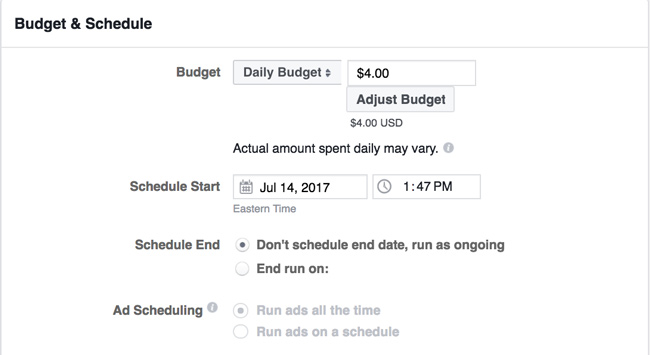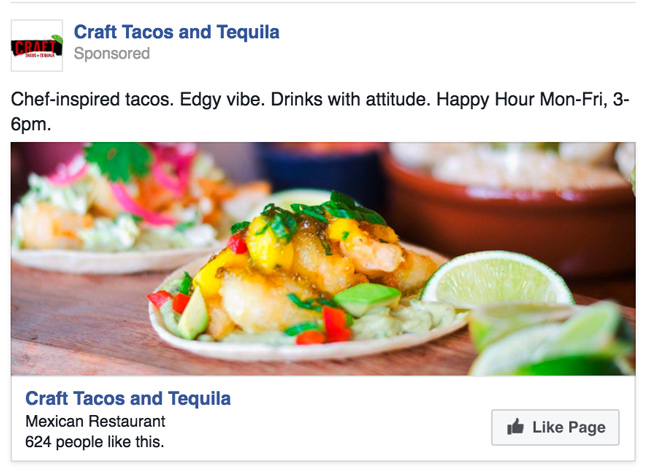While your business is growing, you may be hesitant to invest in online advertising. But with organic search declining and paid promotions dominating the online space, it’s incredibly important to put ad money behind your company.
As a small business, we understand Facebook ads are a part of getting our name out there—but we’ve learned a few tricks to get the most out of our dollars. Read on to discover strategies and actionable steps for setting up a successful small-budget Facebook ad campaign.
Our Approach for High-Impact, Low-Cost Facebook Ads
Although every industry differs, our ad tactics can be applied to a variety of products and services. As a web design and marketing agency, we have several clients in the restaurant/service industry. To explain our approach, we’ll share the setup process and results for these specific client promotions.
1. Start with Your Objective
Before you begin choosing images, copy, or a budget for your Facebook ad, you MUST choose an objective. Every decision you make for the ad revolves around this key goal, whether you’re aiming for more page likes, brand awareness, traffic, reach, or any other objective Facebook offers. Decide what you want, and learn how it’s measured.
2. Set Your Budget
If your business is on a tight budget, you can set a maximum limit for the ad. However, depending on your objective, setting a maximum budget and specific end date may require you to meet a minimum daily limit. (Often $5.00 per day). For several ads, we wanted to spend $4.00 per day. To override this $5.00 minimum amount, we didn’t schedule an end date—and instead kept an eye on daily spend. As we neared our total spending budget, we then set a maximum amount and let it run out completely.

3. Determine Your Audience
Once your objective and budget is in place, it’s time to pick your audience. Besides images and copy, audience is one of the most important components for a successful ad. This is the time to dive into your buyer personas, critically think about your objective, and merge the two together. When building an audience for restaurants, we consider location, demographics, age, competitors, lifestyle, and habits. Remember that your audience depends heavily on your objective, so stay broad or go narrow—just weigh the potential outcomes of each targeting method.
4. Use Impactful Images and Copy
Your ads only have a second or two to capture attention, so make that time count! Choose images that pop, even when viewed on small screens. Write copy that plays to viewers emotions or values by using simple psychology techniques or company value props. Quick, short, on-brand copy has notoriously worked in our ads (especially if a tempting drink or meal is involved).

What We Learned from an $150 Ad Budget
On average, we run client ads with an $150 budget over the course of a month. This means we spend approximately $4.00 per day—almost pocket change when it comes to a running a business. Even if you have to save up to run your first ad, trust us, it’ll be worthwhile. After dozens of ads, here are key takeaways you can apply to your own promotions.
Successful Ad Campaigns Can Have Wide or Narrow Audiences
This may seem counterintuitive, we know. However, if you want to target audiences in your local community, narrow your audience to that city. Then, target a step further to really hit potential customers. For example, when promoting a new restaurant, our team chooses demographics for people who enjoy eating out, trying new restaurants, eating specific food types, drinking with friends, going to girls nights out, and more. You simply have to decide who your audience is (or will be) and put your enticing ad in front of them.
If your business is largely or exclusively online, you’ll want to hit a wide audience in a narrow niche. Don’t waste dollars showing your ad to people across the country who are entirely uninterested in your product. Instead, target nationwide but choose the demographics and interests that match your product or service.
Ads Need Time to Build Traction
It’s exciting to watch the numbers fluctuate once you launch your ads. Our team gets pumped every time we hit a new record for Cost per Like! While it’s important to keep an eye on ads, hold yourself back from pausing or changing any too quickly after launch. Ads need time to build reach and gain relevancy for Facebook’s algorithm. If you’re on a small budget, wait a week before making adjustments to your audience or ads.
Create New Ads Instead of Editing Unsuccessful Ads
You’ll likely want to make changes to your underperforming ads, but instead of editing each, build new ones. Underperforming ads are a great way to learn what your audience doesn’t like to see or engage with. Simply pause the unsuccessful ads and use the highest performing images and copy to create fresh, exciting promotions.
Be Prepared to Learn About Your Business
Putting your ads in front of people who may or may not know your brand is thrilling and daunting. As you build your audience and ad creation skills, there will be surprises, upsets, and triumphs. Our team treats every ad campaign as a learning opportunity to improve messaging, images, and strategy. For one of our restaurant clients, we used menu items for ad images. While we expected the food images to perform the best, it was actually the happy hour and colorful drinks that drew people in. Don’t be afraid to give up an ad or tactic and replace it with one your audience resonates with.
Results from Two Facebook Ads on a Budget
We’ve shared steps to setup your ads. Now it’s time to show our actual results from spending less than $215 on an ad campaign. For both of the campaigns shown below, our clients were two separate restaurants that wanted to increase Page Likes. For privacy and brevity, we’ll call each Restaurant A and Restaurant B.
Restaurant A:
This restaurant was rebranding and wanted to get the local community excited about the new menu. A day before the grand opening, we launched a Page Likes campaign with five ads highlighting their menu and happy hour. We set a daily budget of $5.00 and targeted people within a 15 mile radius with interests related to the restaurant. Here are the results:

Restaurant B:
To gain fans and Page Likes in a saturated market, Restaurant B wanted to try and outbid the competition. As an established restaurant, they were able to spend more on marketing efforts. We set a budget of $8.00 per day for four ads and targeted people within a 15 mile radius. Due to their location, we chose to specifically target a handful of universities and training schools in the area. Here are the results:

Key Takeaways to Make the Most of Facebook Ads
As you can see, Restaurant B earned more page likes, a lower cost per result, frequency, and clicks (not pictured). However, their daily budget was $3.00 higher than Restaurant B. So why the huge difference in results, especially when reach was very similar?
When you get varying results, it’s time to dig into the data and learn from your ads. For these particular ads, the higher results could be from a higher budget—or it could be from better copy, images, and targeted audience. While it’s almost impossible to truly compare ads from two separate clients, these examples show that improvement is always possible and can spark ideas for the next campaign.
Get Help Creating Your Facebook Ads
If you’re ready to see what you can achieve through Facebook ads but don’t have the time to build, track, and analyze a campaign, fill out the form below and we will get in touch with you shortly!
If your the type of person that likes speaking to a live person,
give us a call at 512-222-8488.


